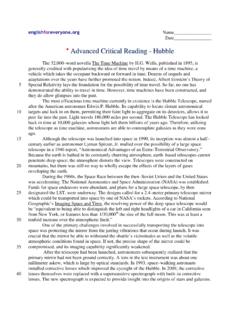Transcription of A-level PHYSICS (7408/3BD) - filestore.aqa.org.uk
1 SPECIMEN MATERIAL Specimen 2014 Morning Time allowed: 2 hours Materials For this paper you must have: a pencil a ruler a calculator a data and formulae booklet a question paper / answer book for Section A. Instructions Answer all questions. Show all your working. The total time for both sections of this paper is 2 hours. Information The maximum mark for this section is 35. A-level PHYSICS (7408/3BD) Paper 3 Section B (Turning points in PHYSICS ) Please write clearly, in block capitals, to allow character computer recognition. Centre number Candidate number Surname Forename(s) Candidate signature 2 Section B Answer all questions in this section. In an experiment to measure the charge of the electron, a spherical charged oil droplet of unknown mass is observed between two horizontal parallel metal plates, as shown in Figure 1. Figure 1 The droplet falls vertically at its terminal speed when the potential difference (pd) between the plates is zero.
2 A droplet of radius r falls at its terminal velocity, v. Derive an expression for r in terms of v, , and g, where is the viscosity of air and is the density of the oil droplet. [2 marks] Explain how the mass of the oil droplet can be calculated from its radius and other relevant data. [1 mark] 0 1 0 1 . 1 0 1 . 2 3 Turn over A potential difference (pd) is applied across the plates and is adjusted until the droplet is held stationary. The two horizontal parallel metal plates are mm apart. The mass of the droplet is 10 15 kg. The droplet is held stationary when the pd across the plates is 1560 V. Calculate the charge of the oil droplet. [2 marks] charge = _____ C A student carries out Millikan s oil drop experiment and obtains the following results for the charges on the oil drops that were investigated. x 10 19 C x 10 19 C x 10 19 C Discuss the extent to which the student s results support Millikan s conclusion and how the student s conclusion should be different.
3 [3 marks] 0 1 . 3 0 1 . 4 4 Figure 2 shows a narrow beam of electrons produced by attracting the electrons emitted from a filament wire, to a positively charged metal plate which has a small hole in it. Figure 2 Explain why an electric current through the filament wire causes the wire to emit electrons. [2 marks] Explain why the filament wire and the metal plates must be in an evacuated tube. [1 mark] 0 2 0 2 . 1 0 2 . 2 5 Turn over The potential difference between the filament wire and the metal plate is 4800 V. Calculate the de Broglie wavelength of the electrons in the beam. [4 marks] wavelength = _____ m Question 2 continues on the next page 0 2 . 3 6 The beam is directed at a thin metal foil between the metal plate and a fluorescent screen at the end of the tube, as shown in Figure 3. The electrons that pass through the metal foil cause a pattern of concentric rings on the screen.
4 Figure 3 The potential difference between the filament and the metal plate is increased. State and explain the effect this has on the diameter of the rings. [3 marks] _____ _____ _____ _____ _____ _____ 0 2 . 4 7 Turn over Maxwell s theory suggested the existence of electromagnetic waves that travel at a speed of 1 o o . Hertz later discovered radio waves and performed experiments to investigate their properties. Figure 4 shows a radio wave transmitter and a detector. The wave is transmitted by a dipole aerial. The detector consists of a metal loop connected to a meter. Figure 4 Explain how the detection of the wave by the loop demonstrates the magnetic nature of the radio waves. [2 marks] Explain how the electric nature of the waves emitted by the dipole could be demonstrated. [1 mark] 0 3 . 2 0 3 0 3 . 1 8 Hertz used an arrangement like that shown in Figure 4 to determine the speed of radio waves.
5 Describe how the speed was determined. Go on to discuss how the experiments of Hertz confirmed Maxwell s prediction and the experimental evidence that suggests that light is also an electromagnetic wave. [6 marks] 0 3 . 3 9 Turn over One of the two postulates of Einstein s theory of special relativity is that the speed of light in free space is invariant. Explain what is meant by this postulate. [1 mark] State the other postulate. [1 mark] Two detectors are measured to be 34 m apart by an observer in a stationary frame of reference. beam of mesons travel in a straight line at a speed of c past the two detectors, as shown in Figure 5. Figure 5 Calculate the time taken, in the frame of reference of the observer, for a meson to travel between the two detectors. [1 mark] time = _____ 0 4 0 4 . 1 0 4 . 2 0 4 . 3 10 mesons are unstable and decay with a half-life of 18 ns.
6 It is found in experiments that approximately 75% of the mesons that pass the first detector decay before reaching the second detector. Show how this provides evidence to support the theory of special relativity. In your answer compare the percentage expected by the laboratory observer with and without application of the theory of special relativity. [5 marks] END OF QUESTIONS Copyright 2014 AQA and its licensors. All rights reserved. 0 4 . 4













